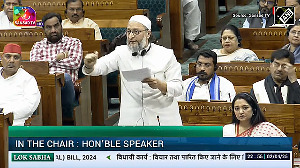The Union Budget 2005-06 proved to be a watershed event for tax-savings funds. Hitherto, investments for the purpose of tax deduction (under the erstwhile Section 88) were subject to upper limits.
For example the cap on tax-saving funds was placed at Rs 10,000; as a result conventional avenues like the Public Provident Fund (PPF), National Savings Certificate (NSC) and life insurance policies dominated investors' tax-planning kitty. By removing sectoral caps on investments eligible for tax benefits, a level-playing field has been created.
Tax-saving funds in their new unbridled avatar look all set to emerge as a strong reckoning force in the tax-saving space.
A tax-saving fund (also referred to as Equity-Linked Savings Scheme) is a diversified equity fund that offers tax benefits. However, unlike typical diversified equity funds, they are subject to a mandatory 3-year lock-in period.
From the tax-planning standpoint, the biggest advantage offered by tax-saving funds is the opportunity to invest in sync with one's risk appetite. Investments for the purpose of tax-saving are no different from conventional investments and the principle of investing in tune with the risk appetite is equally applicable.
Tax-saving funds are similar to diversified equity funds in terms of risk profile, i.e. they are high risk-high return investments. Investors with a flair for instruments of the aforesaid variety would approve of tax-saving funds.
Investing in equities should always be conducted with a long-term horizon; it is over this time frame that equities have the potential to truly unlock their value and outperform other comparable assets. Tax-saving funds (courtesy the mandatory lock-in period) propagate this cause.
The fund manager is not bothered by factors like the fund's performance over shorter time frames or redemption pressures (which the fund manager of a conventional diversified equity fund is subject to) and can go about doing his job with a long-term perspective. From the investors' perspective, tax-saving funds instill a degree of discipline in the investment activity.
Tax-saving funds offer a unique investment proposition since investors are granted the opportunity to invest in a market-linked investment avenue and yet claim tax benefits. Conventionally, the domain of tax-saving instruments has been populated by assured return instruments like PPF and NSC. The higher risk profile in turn also means that tax-saving funds are better equipped to clock superior returns vis-à-vis their assured return counterparts like PPF and NSC.
For investors who attach more importance to returns and have the ability to take on higher risk levels, tax-saving funds are the place to be.
Another area where tax-saving funds (despite the 3-year lock in period) score over their counterparts from the tax-saving domain is liquidity. While investments in NSC run over a 6-year time frame; it scores very poorly in terms of liquidity.
Premature withdrawals are not permitted except in special circumstances like the investor's death or on order by the court of law. Similarly, the PPF has tenure of 15 years; however premature withdrawals are permitted only from the 7th year based on a preset formula.
Having established tax-saving funds' credentials as an efficient device for tax-planning, now let's find out how they score as a pure investment vehicle. For the purpose of this comparison, we shall consider the top performers from the diversified equity funds vis-à-vis those from the tax-saving funds segment over a 3-year period.
Diversified Equity Funds
| Diversified Equity Funds | NAV (Rs) | 1-Yr (%) | 3-Yr (%) | SD (%) | SR (%) |
| RELIANCE GROWTH (G) | 126.64 | 55.03 | 66.41 | 6.43 | 0.85 |
| FRANKLIN INDIA PRIMA (G) | 121.46 | 51.28 | 62.59 | 6.77 | 0.75 |
| RELIANCE VISION (G) | 88.13 | 32.85 | 58.41 | 6.75 | 0.64 |
| MAGNUM CONTRA | 16.37 | 60.21 | 54.88 | 6.20 | 0.87 |
| MAGNUM GLOBAL | 18.42 | 78.76 | 53.17 | 6.24 | 0.92 |
| TATA EQUITY OPP. (G) | 29.01 | 26.85 | 52.79 | 7.27 | 0.69 |
| HDFC CAP BUILDER (G) | 36.98 | 44.92 | 46.30 | 5.91 | 0.78 |
| DSP-ML OPP. (G) | 25.85 | 19.23 | 45.98 | 6.78 | 0.61 |
| HDFC TOP 200 (G) | 51.97 | 21.05 | 45.10 | 6.50 | 0.60 |
| UTI VALUE FUND | 19.55 | 20.27 | 44.61 | 6.37 | 0.56 |
(The Sharpe Ratio is a measure of the returns offered by the fund vis-à-vis those offered by a risk-free instrument) (Standard deviation highlights the element of risk associated with the fund.)
Over the 3-year period, leading diversified equity funds have had an impressive run. Funds like Reliance Growth (66.41%), Franklin India Prima (62.59%) and Reliance Vision (58.41%) have outperformed (albeit marginally) their tax-saving funds counterparts, i.e. HDFC Long Term Advantage(58.46%), Magnum Tax Gain (57.86%) and PruICICI Tax Plan (52.91%).
However, if the tax benefits acquired by investing in tax-saving funds were to be factored in, the latter can match the returns clocked by diversified equity funds.
Tax-Saving Funds
| Tax-Saving Funds | NAV (Rs) | 1-Yr (%) | 3-Yr (%) | SD (%) | SR (%) |
| HDFC LT ADVANTAGE (G) | 50.70 | 49.48 | 58.46 | 5.49 | 0.84 |
| MAGNUM TAX GAIN | 42.95 | 94.29 | 57.86 | 7.11 | 0.90 |
| PRU ICICI TAX PLAN (G) | 49.23 | 67.45 | 52.91 | 7.36 | 0.72 |
| HDFC TAX SAVER (G) | 71.03 | 63.50 | 52.42 | 5.63 | 0.85 |
| BIRLA EQUITY PLAN | 37.96 | 34.23 | 50.53 | 6.66 | 0.66 |
| TATA TAX SAVING FUND | 33.59 | 25.79 | 45.57 | 6.38 | 0.72 |
| SUNDARAM TAX SAVER | 13.61 | 48.59 | 44.36 | 6.11 | 0.68 |
| PRINCIPAL TAX SAVINGS | 38.83 | 25.22 | 40.57 | 5.38 | 0.72 |
| FRANKLIN INDIA TAX. O (G) | 67.30 | 24.51 | 38.45 | 5.66 | 0.66 |
| UTI EQUITY TAX SAVINGS | 18.50 | 25.20 | 37.01 | 5.37 | 0.66 |
(The Sharpe Ratio is a measure of the returns offered by the fund vis-à-vis those offered by a risk-free instrument) (Standard deviation highlights the element of risk associated with the fund.)
There is very little differentiating tax-saving funds and diversified equity funds when comparisons are made on parameters like Standard Deviation and Sharpe Ratio. Standard Deviation measures the degree of volatility which the fund exposes its investors to; conversely Sharpe Ratio is used to measure the returns delivered by the fund per unit of risk-borne.
Even if tax-saving funds were to be considered purely from an investment perspective (i.e. without the tax-planning angle) they emerge as feasible options.
Finally we present an investment strategy for investments in tax-saving funds,
Your risk appetite should at all times determine the total investments in tax-saving funds. Don't go overboard in the segment simply because of the opportunity to rake in impressive returns at the cost of higher risk.
Use the SIP route for investing in tax-saving funds. Not only does it do away with the need for timing markets, it reduces the strain on your wallet at the end of the financial year when most investors conduct their tax-planning exercise.
The dividend option can help. Despite the 3-year lock-in period, the dividend option ensures that investors have access to liquidity and the opportunity to capture any gains during the lock-in period.
While selecting a tax-saving fund, take into account its performance over longer time frames like 3 years and more. Also monitor how other diversified equity funds from the fund house have performed over longer time frames. Shorter time periods like a 1-year period can be misleading while evaluating a tax-saving fund.
This article forms a part of The definitive guide to Mutual Funds (May 2005), a free-to-download online guide from Personalfn. To download the entire guide, click here.
Money Simplified, a publication from Personalfn, is now arguably India's most popular online financial planning guide! Get your free copy today! Click here






 © 2025
© 2025